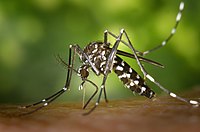
Photo from wikipedia
Background Vector surveillance is an essential public health tool to aid in the prediction and prevention of mosquito borne diseases. This study compared spatial and temporal trends of vector surveillance… Click to show full abstract
Background Vector surveillance is an essential public health tool to aid in the prediction and prevention of mosquito borne diseases. This study compared spatial and temporal trends of vector surveillance indices for Aedes vectors in the southern Philippines, and assessed potential links between vector indices and climate factors. Methods We analysed routinely collected larval and pupal surveillance data from residential areas of 14 cities and 51 municipalities during 2013–2018 (House, Container, Breteau and Pupal Indices), and used linear regression to explore potential relationships between vector indices and climate variables (minimum temperature, maximum temperature and precipitation). Results We found substantial spatial and temporal variation in monthly Aedes vector indices between cities during the study period, and no seasonal trend apparent. The House (HI), Container (CI) and Breteau (BI) Indices remained at comparable levels across most surveys (mean HI = 15, mean CI = 16, mean BI = 24), while the Pupal Productivity Index (PPI) was relatively lower in most months (usually below 5) except for two main peak periods (mean = 49 overall). A small proportion of locations recorded high values across all entomological indices in multiple surveys. Each of the vector indices were significantly correlated with one or more climate variables when matched to data from the same month or the previous 1 or 2 months, although the effect sizes were small. Significant associations were identified between minimum temperature and HI, CI and BI in the same month (R2 = 0.038, p = 0.007; R2 = 0.029, p = 0.018; and R2 = 0.034, p = 0.011, respectively), maximum temperature and PPI with a 2-month lag (R2 = 0.031, p = 0.032), and precipitation and HI in the same month (R2 = 0.023, p = 0.04). Conclusions Our findings indicated that larval and pupal surveillance indices were highly variable, were regularly above the threshold for triggering vector control responses, and that vector indices based on household surveys were weakly yet significantly correlated with city-level climate variables. We suggest that more detailed spatial and temporal analyses of entomological, climate, socio-environmental and Aedes-borne disease incidence data are necessary to ascertain the most effective use of entomological indices in guiding vector control responses, and reduction of human disease risk.
Journal Title: PLoS Neglected Tropical Diseases
Year Published: 2022
Link to full text (if available)
Share on Social Media: Sign Up to like & get
recommendations!